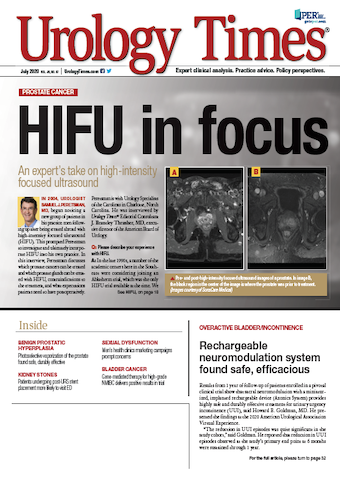Publication
Article
Urology Times Journal
Photoselective vaporization of the prostate found safe, durably effective
Author(s):
Only 1.5% of patients undergo repeat surgical intervention for BPH recurrence.
Analyses of data from prospective follow-up of more than 3800 men show that photoselective vaporization of the prostate (PVP) with a proprietary laser system (GreenLight XPS) is a safe and durably effective procedure for treating lower urinary tract symptoms related to benign prostatic hyperplasia (BPH), said Kevin Zorn, MD.
At the 2020 American Urological Association Virtual Experience, Zorn presented findings on behalf of coinvestigators in the global GreenLight Group, which is comprised of 8 expert surgeons practicing at 7 international referral centers1. He reported that the procedure was completed using just a single fiber in 92.5% of men; resulted in a prostate-specific antigen (PSA) reduction of 53.5% at 24 months, which was comparable to that achieved with other treatments for BPH; and was associated with few major complications. Furthermore, during follow-up of up to 5 years, only 1.5% of men underwent repeat surgical intervention for BPH recurrence.
“There has been accumulating evidence in the literature demonstrating the long-term durability of GreenLight PVP. To our knowledge, our multi-institution, multi-user study is the largest collective experience with this treatment modality,” said Zorn, a professor of urology at theUniversity of Montreal (CHUM) in Quebec, Canada.
The men included in the study were treated with the XPS 180W system between 2011 and 2019. They had a median age of 70 years and a median prostate volume of 65 mL as measured by transrectal ultrasound. Median lobe presence was observed in 36.5% of men, 35% had a Foley catheter preoperatively for urinary retention, and 34% were on anticoagulant therapy other than aspirin.
Median operative time was 62 minutes and median energy used totaled 250 kJ, corresponding to an energy density of 3.9 kJ/mL prostate volume.
“The operative characteristics in this population were typical of what we would expect with this procedure. Operating time tends to average 1 min per mL of prostate volume, and energy use typically ranges from 3 to 4 kJ per mL,” Zorn said.
The perioperative transfusion rate was only 0.8% and the median hospital stay was 2 days.
“It is important to recognize that several of the participating centers were in Europe, where surgeons are obliged to keep patients in the hospital for at least 2 or 3 days because of criteria for reimbursement,” Zorn said.
Median duration of Foley catheterization was 1 day or less in approximately two-thirds of men, and 5.9% of men required recatheterization, which is consistent with other large BPH series, according to Zorn.
Incidental prostate cancer was observed in final surgical pathology in less than 2% of men. Thirteen percent of men were readmitted to the hospital within 30 days, and most of them were on anticoagulant therapy.
Most post-op AEs minor
Postoperative adverse events (AEs) occurring within 30 days after the procedure were categorized using the Clavien-Dindo classification system. Most were minor (grades 1-2), with the most common being lower urinary tract symptoms (22.3%), incontinence (10.4%), hematuria (9.9%), and retention (7.4%). The most common major AEs (grades 3-5) were retrograde ejaculation (4.4%) and postoperative transfusion (1.3%). All other major AEs occurred at a rate of 0.8% or lower.
“The lower urinary tract symptoms were mainly managed with anticholinergics; retention occurred mostly in men who were in retention preoperatively, and most cases of hematuria were managed with hydration without need for hospitalization or a return to the OR,” Zorn stated.
Functional outcomes analyses showed that median PSA was decreased by about 50% throughout follow-up to 5 years. Median International Prostate Symptom Score was 22 at baseline and remained at 4 or 5 between 6 months and 5 years. Median peak flow rate decreased from 6.3 mL/s at baseline to 17 mL/s at last follow-up, and median postvoid residual volume decreased from 122 mL at baseline to 23.5 mL at 5 years.
Discussing limitations of the global retrospective study, Zorn mentioned that because of its global nature and retrospective design, it is difficult to account for variations between surgeons in preoperative medical therapy and skill. In addition, many of the patients returned to their referring urologist after their procedure, so follow-up data needed to be obtained via phone contact.
Disclosures: Dr Zorn is a paid consultant and proctor surgical trainer for Greenlight PVP and Rezum by BSCI (Boston Scientific), an investigator and paid consultant for Procept BioRobotics for Aquablation, and investigator for Zenflow and Urotronic BPH treatments.
Reference
1. Law K, Tholomier C, Couture F et al. Global GreenLight Group: Largest International GreenLight Experience for Benign Prostatic Hyperplasia. Presented at: AUA 2020 Virtual Experience. Abstract PD61-07.


























